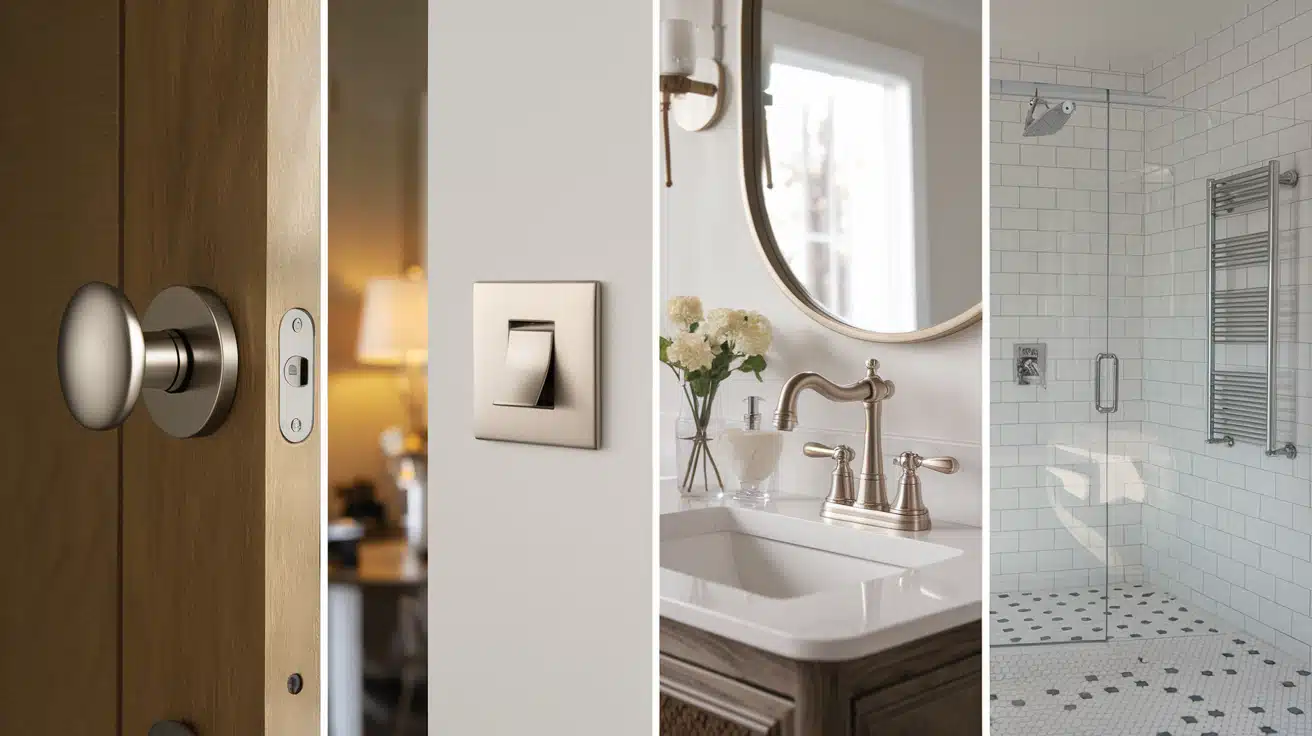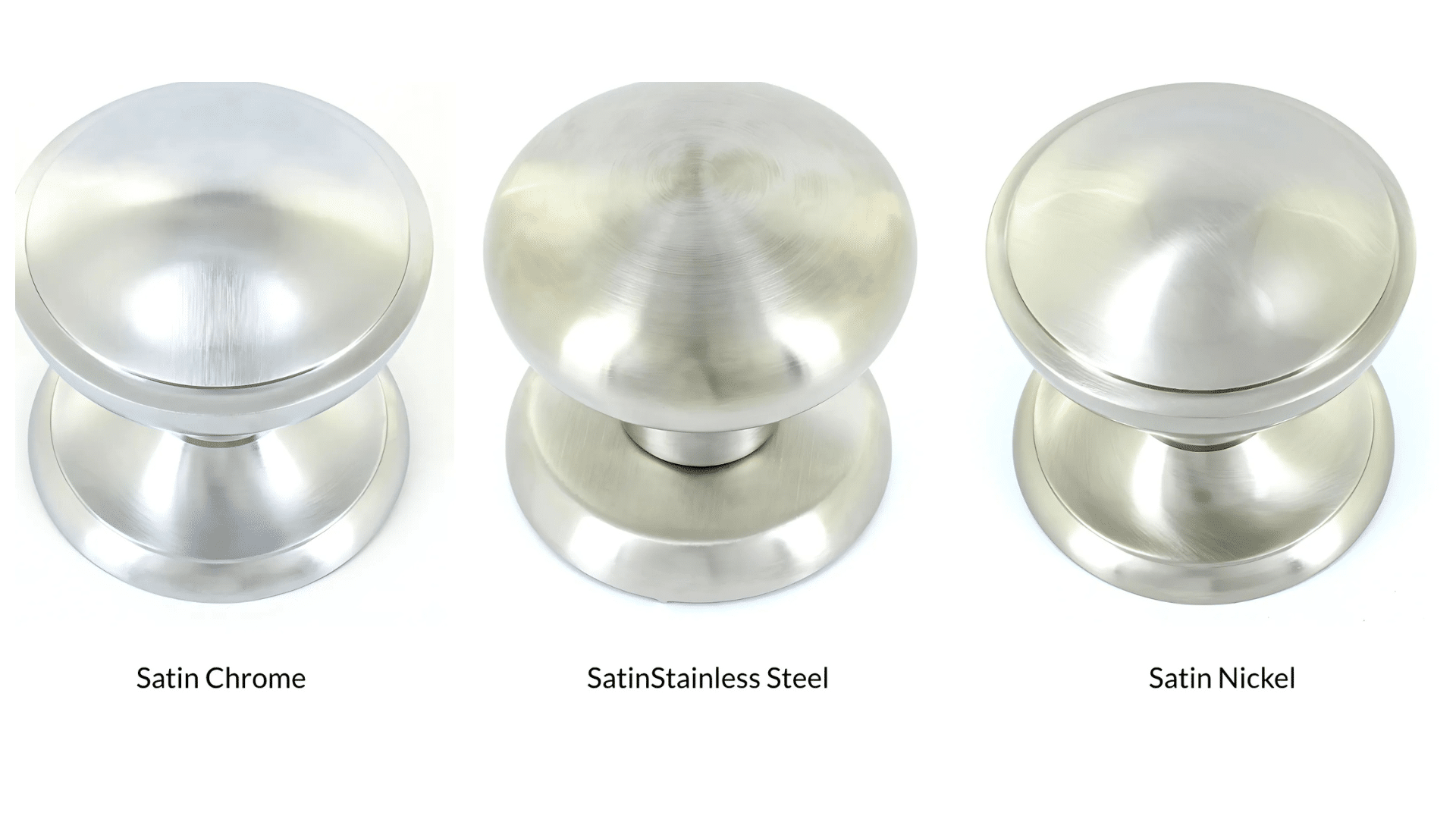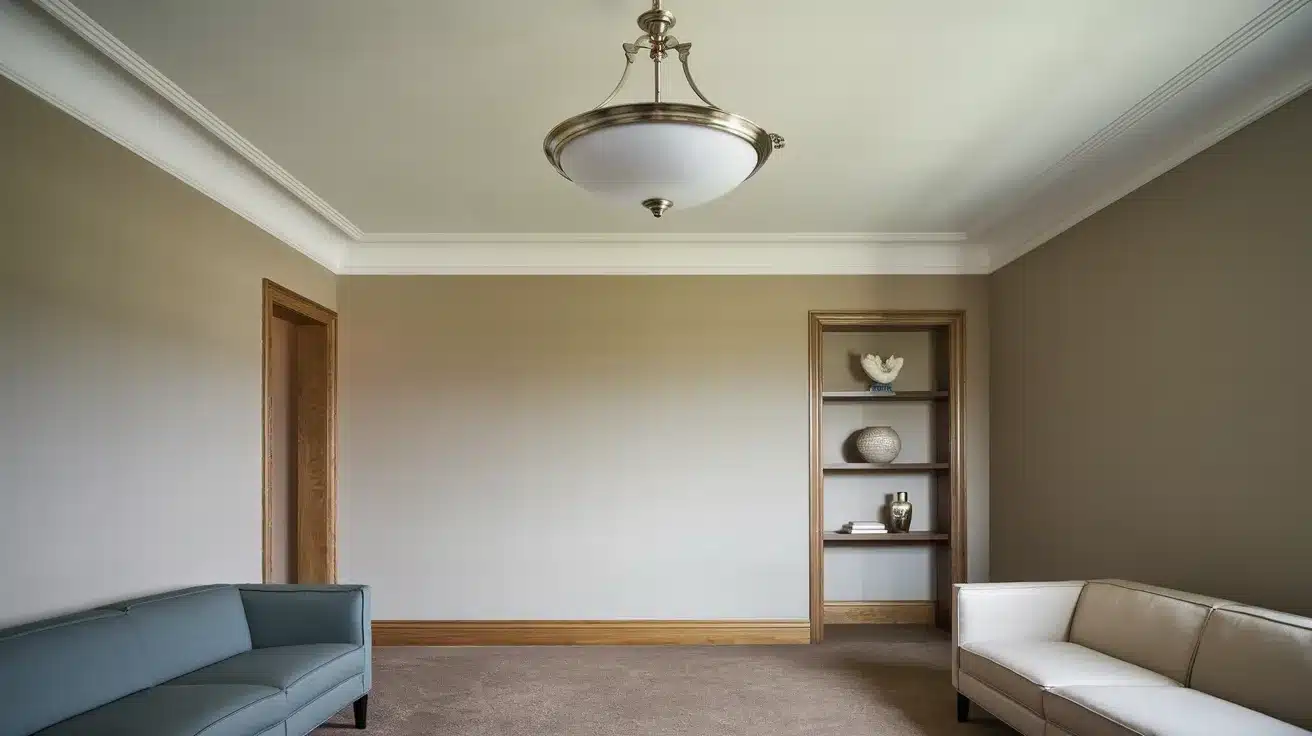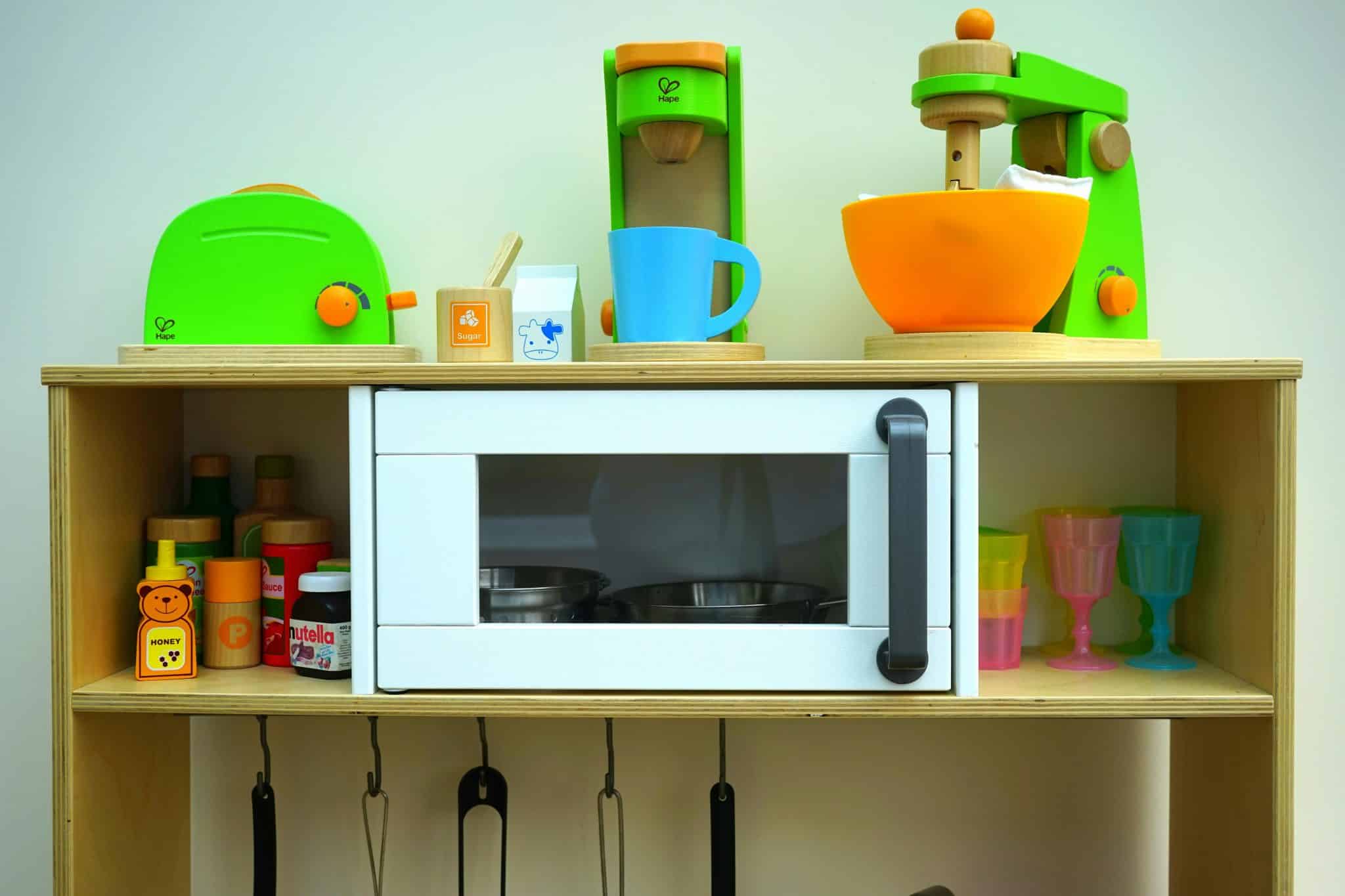In today’s post, I will show you exactly what makes satin nickel color a fantastic choice for home fixtures and hardware.
I’ve spent over 12 years helping homeowners pick finishes, and satin nickel remains one of the most requested options I work with.
The warm, silvery glow of satin nickel adds a subtle sophistication that beautifully complements both modern and traditional spaces.
Want to know what makes this finish so special? You’re in the right place.
I’ll explain everything about this unique color, from its distinctive characteristics to how it compares with other metal finishes, so you can decide if it’s the right choice for your home.
Let’s start exploring.
What Makes Satin Nickel Special?
Satin nickel offers a smooth, muted finish that catches light without being flashy. It is the perfect compromise between polished and matte metals.
When you look at a satin nickel doorknob or faucet, you’ll notice a soft, warm glow that feels welcoming and refined.
How It Compares to Other Finishes
| Finish Type | Color Tone | Surface Look | Light Reflection |
|---|---|---|---|
| Satin Nickel | Warm silver | Smooth, even | Soft, diffused |
| Chrome | Cool silver | Highly polished | Mirror-like |
| Stainless Steel | Natural silver | Slightly textured | Moderate |
The Science Behind Satin Nickel
Understanding satin nickel starts with its base components. Solid brass is the most common foundation for satin nickel pieces, though manufacturers now use various materials to create quality items at better prices.
Base Materials That Make It Special
The durability and appearance of a product depend heavily on its base material. Solid brass remains the traditional choice, offering timeless appeal and lasting strength.
Zinc alloy provides a more budget-friendly alternative while maintaining durability. Mazac, a modern option, balances affordability with a sleek finish.
Aluminum stands out for its lightweight properties, making it easy to work with.
Stainless steel, known for its strength and resistance to corrosion, ensures long-term reliability. Each material brings unique benefits, allowing for a selection that best suits specific needs and preferences.
The Making of Satin Nickel
The process involves careful steps that create this unique finish. First, manufacturers apply a layer of copper that acts as a primer coat. This step helps the nickel bond better and last longer.
Then comes the nickel plating – a process where nickel particles attach to the surface through an electrical current.
| Process Step | Purpose | Result |
|---|---|---|
| Copper Layer | Priming | Better bonding |
| Nickel Plating | Main finish | Silver-tone |
| Sanitizing | Surface texture | Matte look |
| Lacquering (optional) | Protection | Extra durability |
Satin nickel works well in various room settings
Kitchen Combinations
White cabinets paired with gray countertops create a clean, modern look with a soft contrast that remains effortlessly stylish.
Warm wood tones complemented by black appliances add depth and richness, blending natural and contemporary elements.
For a bold yet balanced design, blue cabinets with white countertops provide a fresh, vibrant contrast that feels classic and inviting.
Bathroom Pairings
White tile with gray accents offers a crisp, elegant aesthetic that blends modern simplicity with subtle contrast.
Cream walls paired with brown wood create a warm, inviting atmosphere, balancing softness and natural richness. For a refreshing and airy feel, light blue complemented by white fixtures brings a clean and serene touch to any space.
Living Areas
Neutral walls with wood trim create a timeless and inviting look, allowing natural wood tones to stand out beautifully. Cool grays and white molding offer a crisp, modern contrast that enhances architectural details.
For a cozy and grounded feel, warm beige tones and dark floors provide depth and richness, making the space feel elegant and welcoming.
How Does Satin Nickel Create Visual Impact?
Unique Color Profile
Satin nickel offers a refined silvery hue with delicate golden undertones, balancing glossy and matte finishes. Its smooth surface evenly reflects light, creating a soft sheen that enhances various design styles.
When viewed up close, the finish reveals a subtle warmth beneath its silver base, ensuring a consistent and sophisticated appearance from every angle.
Light Play and Texture
Satin nickel responds beautifully to lighting conditions, enhancing its depth and character. In the morning, soft golden undertones become more noticeable, adding warmth to the finish.
The silver base takes center stage as evening sets in, creating a cool, refined look. Under indoor lighting, the surface emits a gentle glow, balancing muted and reflective.
Natural daylight further enhances its texture, revealing subtle variations that give the finish a sense of depth and sophistication.
Working with Color Schemes
The most harmonious pairings include:
| Wall Colors | Cabinet Colors | Countertops |
|---|---|---|
| Soft whites | Light oak | White marble |
| Pale grays | Dark walnut | Black granite |
| Cream tones | Navy blue | Beige quartz |
| Light blues | Forest green | Gray concrete |
Comparing Popular Metal Finishes
Satin Nickel and Brushed Nickel: A Closer Look
While these finishes may seem similar at first glance, they have distinct characteristics. Satin nickel offers a smoother surface with a consistent sheen.
The finish comes from a specialized plating process that creates an even, streak-free appearance. Brushed nickel, however, shows fine lines from the brushing process, giving it a more textured look.
In terms of durability, both hold up well in daily use. Satin nickel tends to keep its original look longer, while brushed nickel may need more frequent cleaning to maintain its appearance.
Price-wise, satin nickel often costs slightly more due to its complex manufacturing process.
Chrome vs Satin Nickel: Temperature and Tone
The main difference between chrome and satin nickel is their color temperature. Chrome has a crisp, cool brightness that reflects light like a mirror.
Satin nickel is the finish sparkling in modern bathrooms and kitchens. Its warmer undertones create a softer presence that blends well with natural materials.
Regarding maintenance, chrome more readily shows water spots and fingerprints than satin nickel. However, chrome maintains its bright finish longer without developing a patina.
Understanding Stainless Steel Differences
Stainless steel and satin nickel share some qualities but serve different purposes. Here’s a practical comparison:
| Feature | Satin Nickel | Stainless Steel |
|---|---|---|
| Color | Warm silver | Cool silver |
| Cost | Mid-range | Higher-range |
| Care | Easy | Moderate |
| Use | Indoor focus | Indoor/Outdoor |
| Patina | Develops over time | Stays consistent |
Top 10 Best Uses of Satin Nickel in Home Design
1. Kitchen Cabinet Handles & Knobs
Satin nickel pulls and knobs bring lasting style to kitchen cabinets. The soft, brushed finish resists fingerprints, adding clean lines and subtle shine.
These pieces work equally well with painted or wood cabinets, making them a smart choice for modern and classic kitchens.
2. Bathroom Faucets & Shower Fixtures
The brushed finish of satin nickel stands up beautifully to daily water exposure in bathrooms.
Faucets and shower heads in this finish offer a perfect blend of style and function, with a surface that maintains its good looks while hiding water spots.
3. Door Handles & Hinges
Satin nickel door hardware creates a cohesive look throughout your home. The matte metallic finish maintains its appeal through years of use.
Door levers and hinges in this finish complement any wall color while providing reliable, smooth operation.
4. Light Fixtures & Chandeliers
Overhead lighting in satin nickel adds warmth without overwhelming your space. This versatile finish works well in any room, from statement chandeliers to simple flush mounts.
The gentle sheen catches light beautifully, while the brushed surface keeps the look subtle and refined.
5. Drawer Pulls for Modern & Traditional Furniture
Update dressers and cabinets with satin nickel drawer pulls. This adaptable finish bridges the gap between old and new styles. The subtle metallic tone adds interest without competing with wood grains or painted surfaces.
6. Window Hardware & Curtain Rods
Window treatments shine with satin nickel hardware. Curtain rods and finials in this finish provide a clean backdrop for fabrics while adding understated detail.
The brushed surface reduces glare from natural light while maintaining a consistent look with other room hardware.
7. Wall Hooks & Accessories
Small details make a big impact with satin nickel wall hooks and accessories. These practical pieces blend function with style.
The finish remains attractive even with frequent use, making it perfect for busy mudrooms and bathrooms.
8. Front Door Hardware & Locksets
Make a great first impression with satin nickel front door hardware. This finish stands up to the weather while maintaining its appeal.
Entry sets and locksets in satin nickel offer security with style, creating an inviting entrance that coordinates with interior and exterior elements.
9. Mirror & Picture Frames
Satin nickel frames provide the perfect setting for mirrors and artwork. The subtle metallic finish adds depth without stealing attention from their showcase pieces.
These frames maintain their good looks in humid spaces like bathrooms while complementing other metal finishes.
10. Outdoor Fixtures & Mailboxes
Extend your home’s style outdoors with satin nickel lighting and mailboxes. This finish withstands the elements while keeping its clean appearance.
Porch lights, house numbers, and door knockers in satin nickel create a polished look that welcomes visitors day and night.
Daily Maintenance Tips for Satin Nickel
Keep Water Off Surfaces
Wipe fixtures with a soft, dry cloth after each use in bathrooms and kitchens. This simple step prevents water spots and mineral buildup. Consider applying a light coat of furniture wax every six months to create a protective barrier against moisture.
Control Mineral Deposits
In areas with hard water, dry handles, and faucets thoroughly after each use. For the best results, use a microfiber cloth. For extra protection, apply a thin layer of mineral oil monthly to repel water and prevent calcium deposits.
What Are the Best Cleaning Products for Satin Nickel?
Safe Cleaning Solutions
Mix gentle dish soap with warm water for regular cleaning. Avoid harsh chemicals, bleach, or abrasive cleaners that can damage the finish. A mixture of equal parts white vinegar and water also removes light buildup.
Recommended Tools
Use soft microfiber cloths or cotton rags for cleaning and drying. Avoid paper towels or rough materials that might scratch the surface. Keep a designated set of cleaning cloths just for your metal fixtures.
Conclusion
Satin nickel stands strong in 2025 home design, offering more than good looks. This finish brings proven value to homes while fitting smoothly into any style.
From busy kitchens to main bathrooms, satin nickel handles daily use gracefully, keeping its appeal year after year.
Its success comes from smart features: water spots fade away, fingerprints barely show, and the soft sheen stays fresh with basic care.
For homeowners planning updates or full renovations, satin nickel offers a wise investment that pays off in function and resale value.
Looking ahead, this finish continues to win praise from buyers and professionals alike.
The blend of timeless style and practical benefits makes satin nickel a top pick for homes that need to look good and work well for years to come.

























